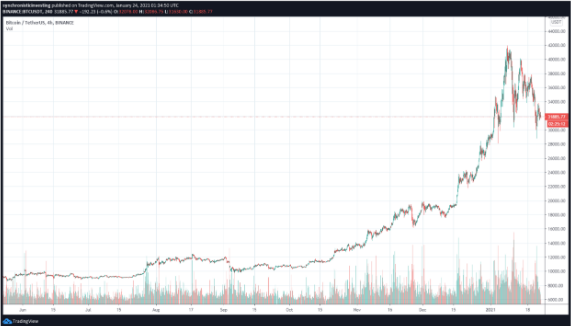Bitcoin’s realized volatility is at its highest level, similar to the ones seen in March 2020 but this is not necessarily a bad thing. In our today’s Bitcoin news, we are taking a closer look at the analysis.
Bitcoin’s realized volatility refers to the average fluctuation of the coin’s price in a 30-day period and the data from Skew shows that it measured volatility by working out the standard deviation in the BTC price over time. Over the past month, the figure touched 103% as the data shows. This means that in the past 30 days, the BTC price deviated from the average price of 103%.
Bitcoin realised volatility continue to climb, highest since 2020 March crash. pic.twitter.com/iz5ADzFoYZ
— unfolded. (@cryptounfolded) January 24, 2021
Contributing to this fact were the sudden peaks in prices for BTC. The huge sell-off caused BTC to suffer its biggest price drop yet and in the weeks before, BTC hit $41,000 which was the highest price ever. The volatility figures are still small to the ones in March when BTC crashed once the pandemic started but now the difference is we are in a bull run. During bull runs, the price fluctuations are more common because investors are able to cash out different points. An analyst from Quantum Economics Pedero Febrero said:
“The more volatility the price has, the greater the magnitude of the change in the prices of bitcoin. During bull runs, this is to be expected.”

Despite Bitcoin’s volatility, it did outperform other assets like gold over the past year. The overall volatility of BTC is now going down as the price and the market cap of the cryptocurrency increased over time but the volatility of the asset dropped. Over the past year, BTC and other cryptocurrencies are performing better than traditional investments as one investor tracked ten cryptocurrencies and said that the altcoins performed over eight-time better than the US stock market as his investment grew 139% while the S&P500 was up 16%.
After a few consecutive days of price drops, BTC regained value and jumped to about $33,000 but most alternative coins outperformed their leader with some strong gains and reduced its dominance on the market to 64%. The past few days were quite harmful to other altcoins as the cumulative market capitalization lost about $200 billion to below $900 billion. However, most of the altcoins bounced back in the past 24hours with some strong gains.
DC Forecasts is a leader in many crypto news categories, striving for the highest journalistic standards and abiding by a strict set of editorial policies. If you are interested to offer your expertise or contribute to our news website, feel free to contact us at [email protected]






















Discussion about this post